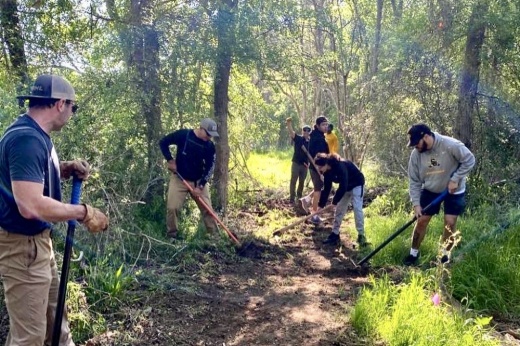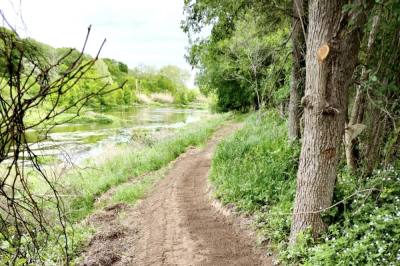In partnership with the university, nonprofit Georgetown Trails Foundation is working to clear natural, multiuse paths on a portion of the university’s property along the San Gabriel River.
The area being transformed into trails is largely unnavigable, said Paul Secord, Southwestern University’s vice president for university relations, but will provide views of the river and a historic railroad trestle bridge once completed.
The project is spearheaded by the foundation, an organization working to expand the city’s existing system of natural unpaved or graveled trails. Ultimately, foundation board member Cove McCormick said, the foundation’s master plan will add 43 miles of natural trails within the city limits.
Work on the trail near Southwestern began March 25, starting at the Katy Crossing Loop Trail trailhead. Foundation board Vice President Aaron Zander said volunteers, a majority of whom are university students, cleared about a half-mile of natural trail over the course of a couple of weekends.
“We’ll go in and clear the corridor, make it safer that way [and] easier for families to access it or even those that aren’t as capable of crawling through, over and under things,” Zander said.
Zander estimates the per-mile cost to create natural trials is around $50,000, not inclusive of maintenance. Much of the work for this project will be carried out by volunteers, he said, and is expected to conclude later this year. Information about volunteering for dig days and a map of the foundation’s trails are available at www.georgetowntrails.org.
McCormick said the foundation will soon begin offering opportunities for volunteers to “adopt” a mile of trail and assist with its upkeep.
One of the easiest ways to maintain a trail is to use it, McCormick said.
“It just keeps vegetation in place and makes everything more accessible,” he said. “Traffic is important to sustaining a trail system.”
Zander said eventually there will be a new trailhead on the university’s campus before tying into another existing trailhead on the opposite side of the university’s property. Secord said the trail will not only allow students to be more connected to the city, but also to the natural environment around the university.
“They don’t need to drive or bike to a trailhead,” Secord said. “It’ll be right here and open to them.”
Creating connections
The trails underway on the Southwestern University campus will connect and interplay with existing trails and paths.
Trailblazing
Cove McCormick, a Georgetown Trails Foundation board member, said the foundation uses a four-step process to create natural trails.
1. Scout: Find a location suitable for a cleared and established trail.
2. Flag: Place high-visibility flags to mark out the direction of the trail.
3. Clear the corridor: Clear the pathway of debris, limbs or any other obstructions, and mow grass if necessary.
4. Scratch: Remove vegetation and roots from the path, leaving a natural hike and bike trail.
Source: Georgetown Trails Foundation/Community Impact






